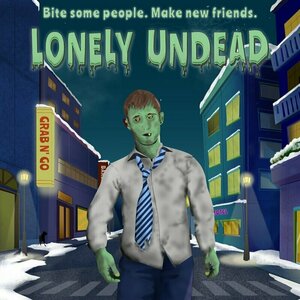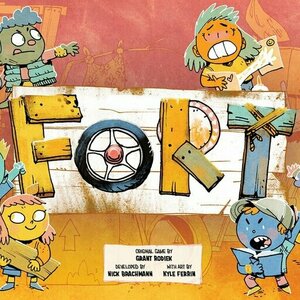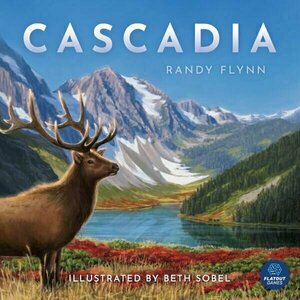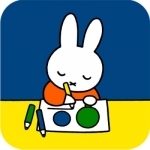
Miffy at school
Book and Education
App
Reading together, playing and learning Miffy is at school where she learns how to count and write,...
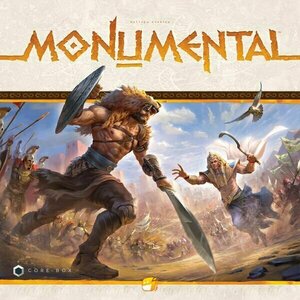
Monumental
Tabletop Game
In Monumental, each player will control a civilization that will evolve through his city: a grid of...

Villagers
Tabletop Game
Villagers is a tableau building and card drafting game for one to five players, set in a faraway...
BoardGames Cardgames Kickstartergames 2018Games
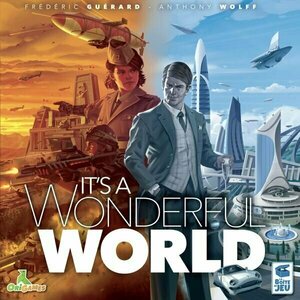
It's a Wonderful World
Tabletop Game
In It’s a Wonderful World, you are an expanding Empire and must choose your path to your future....
Purple Phoenix Games (2266 KP) rated Lonely Undead in Tabletop Games
May 24, 2021
Lonely Undead is a hand management, grid movement, zombie adventure game for one to four players with a super crazy theme. In it, players are Zs looking to make some friends in the neighborhood, but most unturnt neighbors are keeping their distance. So what’s a Z to do? Go bite and infect people so they can be friends forever, of course!
DISCLAIMER: We were provided a prototype copy of this game for the purposes of this review. These are preview copy components, and I do not know for sure if the final components will be any different from these shown. Also, it is not my intention to detail every rule in the game, as there are just too many. This preview will be highlighting the co-op mode with two players. You are invited to download the rulebook, back the game through the Kickstarter campaign, or through any retailers stocking it after fulfillment. -T
To setup, lay out the board somewhere on the table (thankfully the rules do not specify where, so go ahead and be a bit off-center this time). Zs (the players) all start in “Dead Center” of the board. The rulebook indicated how to construct the Living deck, and each deck of different types of cards should be shuffled and put in their place either on the board or just off it. For sake of ease, use the rulebook’s suggested placement of Living (so, NOT the Zs) tokens. Each player receives or chooses a Z to embody, receives two Aid cards, four Limbs, and the game is setup and ready to begin!
Lonely Undead is played over a series of rounds, with each round consisting of two phases: Z Phase and Town Phase. During the Z Phase, the active player will have four actions they may take from the following choices: Movement, Draw an Aid Card, Equip a Card, Sound Check, Attack, and Bite. Each Z has their own unique card with their special actions and other stats. A Z may move up to their Movement amount,including diagonally, for one action.
Aid Cards are very helpful to Zs, and for an action a Z may Draw an Aid Card to their hand. Aid Cards could be stat modifiers, or other special actions available to be used. Some Aid Cards are free to use, but if that text is not on the card, a Z will need to spend an action to Equip a Card to their Z.
When the Z is adjacent to a Living token, they must Sound Check it in order to identify the kind of Living they are stalking. To do this a Z rolls the Chance Die and applies any modifier rolled to their base stat on their card for hearing. This is compared against the Living card that is drawn to see if the Living notices the hunting Z. If the Z is successful in this Sound Check (winning all ties), then the Z may continue with their turn. If the Z fails the check, however, the Z will suffer the consequence detailed on the Living’s card. Once the Living has been identified through a Sound Check (successfully or not), the Z may next Attack the Living by rolling the Chance Die again and applying the modifier to the base attack stat. If successful, the Z flips the Living token over to reveal the injured side, notating that the Living does not need to be Sound Checked again, and is ripe for the bitening. If the Z fails an Attack, though, they will suffer any consequences detailed on the Living’s card. When a Living is injured, they are vulnerable to a Z’s Bite. The Z will roll the special Bite die in an attempt to meet their Bite range on the Z’s character card. A successful Bite means the Z collects a friend and moves that much closer to victory! A failed Bite means the Z must place a color-matched Bite token on the Living standee to signify they cannot be Bitten by that same Z again.
Once a Z has taken their turn, they will draw a Reaction card from its pile. Reactions could be either beneficial to the Z, or could be very very bad news. Some Reaction cards bring Dogs into the game, and these Dogs chase and bite the Zs that drew them. Every Dog bite causes damage to the Z and after all their Limbs are gone, they are perma-dead and out of the game. Other Reactions could cause a Car to zoom down the street, mowing over anything in their path (Zs, Dogs, Living, etc).
In the cooperative mode, players work together to gain 15 friends before 10 Living perish and are placed on the Death Toll tracker. Every two Living tokens on the Death Toll tracker forces the players to draw and enact a Death Toll card. Once the win condition is met the players win!
Components. Again, this is a prototype copy of the game, so components will probably be a bit different in the final version. That said, I do have some opinions here. Firstly, there are a LOT of components included in this game. I am sure that they will all receive some kind of improvement in the final copy, so I will not comment on quality. I was able to play the prototype several times and had no problems with the components doing their job. I do have a comment on the art style. It’s just not my favorite. Now, this is obviously personal opinion, and it certainly does does not turn me off from the game at all. I just need to get it out to the aether that a different art style or genre may fit the game a bit better.
That all said, I THOROUGHLY enjoyed all my plays of Lonely Undead. Once the turns start cookin, you just don’t want to stop playing. Yes, there are random events or spawns that cause some chaos for our heroes, chief of which are the Dogs. Those little buggers will chase you all over town to get that juicy bite off and take one of your Limbs. I hate to say this, but there were many times I hoped to draw a Car card so that it could run over the Dogs (now, in real life I love dogs, but they are perfectly annoying in Lonely Undead). The variety of Z special powers lead to interesting combinations when playing co-op or competitively. However, I honestly prefer the co-op mode here.
In co-op, players are (obviously) working together to Bite and infect as many Living as they possibly can. This makes for some strategic placement between players, as well as combat tactics when Livings are clustered together in a building. Perhaps one Z is better at handling Officers, while another can more easily prey upon Livings from outside areas. Being able to set strategies and tactics by working together has made for some very excellent gaming experiences.
I’m going to be honest, as I always try to do. When I opened up Lonely Undead and saw the art style, I was a bit turned off. But, as I learned the game and played through it several times, I grew to really enjoy the game. I think it’s a great example of taking a tired theme and breathing a bit of new life into it. Yes, zombies are trying to eat people, but typically in zombie games the players are working AGAINST the zombies, not AS the zombies. I think this is a very clever spin. I have certainly and purposefully left out a few rules as surprises for gamers who decide to back this one, and I would recommend that you at least check out the Kickstarter campaign. This may not be for everyone, and even if the art doesn’t change, it is definitely for me. Kudos to Shelby Matussak and Dead Lemon Games for a fine first entry into the gaming world.
CHOMP!
Purple Phoenix Games (2266 KP) rated Fort in Tabletop Games
Jul 27, 2021
Fort is a hand management, deck-building game with a follow mechanic for two to four players. In it, players are assuming the roles of everyday kids trying to build their forts, play with their toys, and eat pizza with their buddies. The winner of the game is they who is able to score the most victory points (VP) at the end of the game, which can end in one of three different fashions.
DISCLAIMER: We were provided a copy of this game for the purposes of this review. This is a retail copy of the game, so what you see in these photos is exactly what would be received in your box. I do not intend to cover every single rule included in the rulebook, but will describe the overall game flow and major rule set so that our readers may get a sense of how the game plays. For more in depth rules, you may purchase a copy online or from your FLGS. -T
To setup, each player chooses a player color and takes all items belonging to them, including the Best Friends cards from the stack. Every other component is then separated by type and cards shuffled. Per the rules, some decks of cards will only have a certain amount on the table, whereas the main deck of kid cards is always used. Each player will draw eight kid cards from the deck to add to their Best Friends and shuffle them. They will also place their score markers on the 0 space of the Victory Track board. Randomly determine the starting player and give them the coveted First Player card, and the game may now begin!
Fort is played in turns, with each turn consisting of five phases (the first phase is skipped on the first turn). The first phase is Cleanup. To Cleanup, the active player takes all kid cards remaining in their Yard and places them in their own discard pile. Next, the active player will Play a kid card from their hand. On each card is a space for up to two actions to be taken: the public action on top and the private action on bottom. The player may complete both, but MUST complete at least one of the actions in its entirety. If using the public action of the card, then other players at the table may also follow the action by discarding one card of the matching suit of the card originally played. However, the leader (active player) may also play additional cards from their hand, of the same suit, in order to boost the effects of the actions. Followers may not. These actions include gaining “stuff” (pizza and toys) to be placed in their Stuff area or backpack, trashing cards in their hands, or gaining VP.
After the players have Played cards, the next phase is Recruit. The active player may choose any kid card that exists in the Park (the space underneath the Victory Track that is always full of kids), another player’s Yard (the space above the player’s main board that they neglected to play with their previous turn), or they may simply draw a kid card blindly from the Park deck. These kids are sent directly to the discard pile to be drawn on a later turn.
Finally, phases four and five end a player’s turn. Phase four is Discard, where the active player will discard all their Best Friends, kid cards they played this turn, and recruited kids. The kid cards leftover that were not used are sent to the player’s Yard above their main boards to possibly be stolen by another player during their Recruit phase. After Discarding, the final phase is Draw, where the active player will draw another hand of five cards to prepare to follow other players and to prepare for the next round. Fort continues in this fashion of each player taking turns and following others’ actions until one player earns 25 VP on the track, any player increases their Fort to level 5, or the Park deck becomes empty. All players will finish their turns so that they all have played an equal amount of turns, and then the players total their scores to crown the winner!
Components. This game has super great components. The little pizza and toys bits are awesome, the double-layered boards are cool, and the art is amazing as well. If it looks familiar in style, it’s because you have seen this art on Root, Oath, and Vast, among others. I love it so much and it is a perfect match for this theme. I really have little negative to say about Fort except that I wish the player colors were different. The orange and yellow are a little close in hue, and the brownish/olive is drab. Everything else, though, *chef’s kiss.
It is probably no surprise why I love this one. Deck-building has long been one of my favorite mechanics, and I have always enjoyed the follow mechanic found in Tiny Epic Galaxies and Villages of Valeria. Mix those up with much more going on and an excellent theme and it’s definitely a big time winner for me. I think what puts me over the edge here is that cards can be used for a couple different actions, and they can be boosted with the right strategies. Get your deck in order to really maximize each turn and the game opens up for you. Several times I have been able to focus my deck and really pound some powerful abilities, but it certainly doesn’t always work out for me, especially when others catch on to what I am doing and hate-draft me into other tactics.
If you are into a fresh new look at deck-building and enjoy more wacky themes, as I do, then I urge you to check out Fort. Officially, Purple Phoenix Games gives this one a playful 5 / 6, but even though it probably won’t break into my Top 10, I do think it will come to the table more often than most games in my Top 10. So should I reconsider my Top 10? Hmm. Anyway, Fort is awesome and everyone I have played with seem to agree with me. So grab a copy or two for yourself. Heck, the gift-giving season is fast approaching, and I know these fit very well under trees and other significant symbols of festivities…

Nationwide Mobile Banking
Finance
App
Stay in control of your finances at your convenience with our handy Mobile Banking app. To get...

Black Rose Wars: Rebirth
Tabletop Game
Black Rose Wars: Rebirth is a competitive fantasy game of deck-building, strategy, and combat set in...
Merissa (13585 KP) rated One Wish Away in Books
Dec 17, 2018
This book has a unique (as far as I know) concept in that scientists have figured out the way to harness the energy from stars into actually making wishes come true. The name for this project is the Cricket Project ie Jiminy Cricket from Pinocchio.
It is a slow burner that builds up and tries to incorporate a lot of different elements into it - high school, romance, sci-fi, government plots, time alteration to name just some. Because of this, it can be quite jumpy as it flits from one aspect to another. There were also some aspects of it that just seemed completely unbelievable - and that's if you turn a blind eye to the actual star part of it. For example, a 16-year-old that thinks it is perfectly acceptable to go sneaking into a government building by stealing her dad's pass-card. And then nothing happens once she is caught except that she is offered a job!
An interesting concept with a twist but just not right for me. I liked it but I won't be going any further with the series.
